An Application of BOTDR to the Measurement of the Curing of a Bored Pile
Abstract
:1. Introduction
2. Principle of BOTDR
- —the amount of change in Brillouin frequency shift.
- —the Brillouin frequency shift corresponding to the ambient temperature T and the strain ε.
- —the Brillouin frequency shift corresponding to the initial temperature T0 and the strain is 0.
- —the temperature coefficient,
- —the strain coefficient,
- —the initial temperature.
- —the actual amount strain of optical fiber.
- —the initial strain of optical fiber.
3. Field Test
3.1. Project Overview and Geological Conditions
3.2. Optical Fiber Sensor and BOTDR Demodulator
3.3. Monitoring Scheme
3.4. Data Processing
4. Analysis of Monitoring Data
4.1. Analysis of Pile Strain Data
4.2. Compare of Strain Distribution of the Pile
- —free deformation of concrete;
- —deformation of concrete produced by temperature;
- —the self-shrinkage of concrete.
- —the temperature change, °C;
- —expansion coefficient of early concrete.
- —thermal expansion coefficient of concrete at 28 d; in this paper, the value is 10−5/°C;
- m—age correlation coefficient, m = 2.0;
- t—age of concrete, d;
- —final self-shrinkage deformation, με;
- —water cement ratio of concrete. In this paper, the value is 0.5.
5. Conclusions
- (1)
- The distributed optical fiber sensing technology based on BOTDR is used, and the accurate data of the pile strain are obtained to study the curing of concrete bored pile deformation; it reflects the advantage of distributed optical fiber sensing technology in the pile foundation monitoring. The hydration heat is released continuously over time, while the temperature of the pile body is confined to the surrounding soil layer. The variation of temperature at different depths is related to the temperature of surrounding soil layer, it affects the strain distribution of the pile.
- (2)
- Based on the comparison between the strain distribution of the pile body obtained by BOTDR and the theoretical calculation value, the soil around the pile and the underground constant temperature layer have a significant influence on the pile body strain. The distributed optical fiber can adequately monitor the deformation of the concrete pile during the concrete curing period, especially the pile strain caused by the heat of hydration; it is helpful to the quality control of concrete piles during the curing period.
- (3)
- Integrated soil information and monitoring result analysis confirms that the pile deformation in the middle of silty clay layer, powder soil, and silt layer and other hard restriction in soil is larger, and it will affect the quality and bearing capacity of the pile.
Author Contributions
Funding
Institutional Review Board Statement
Informed Consent Statement
Data Availability Statement
Acknowledgments
Conflicts of Interest
References
- Wei, M.C.; Meng, Y.D.; Zhu, C.; Fang, J.C.; Kong, G.Q. Field experiment on hydration effect of backfill bored cast-in-place pile and concrete bearing platform. J. Disaster Prev. Mitig. Eng. 2019, 39, 622–627. [Google Scholar]
- Fang, J.C.; Kong, G.Q.; Chen, B.; Che, P.; Peng, H.F.; Lv, Z.X. Field test of influence of concrete hydration on thermodynamic characteristics of pile group. Rock. Soil. Mech. 2019, 40, 2997–3003. [Google Scholar]
- Chen, W.C.; Yang, W.J.; Ren, L.; Shen, Z.P. Axial temperature field and strain test of bored pile in sandy soil foundation. Sino-foreign Highw. 2008, 38, 151–157. [Google Scholar]
- Tang, L.Y.; Yang, G.S.; Jean, Y.Y.; Wang, Z.B. Analysis on the influence of hydration heat on pile foundation heat in permafrost region. J. Xi’an Univ. Sci. Technol. 2011, 31, 28–32. [Google Scholar]
- Cussion, D.; Reprtte, W.L. Early-age cracking in reconstructed concrete bridge barrier walls. ACI Mater. J. 2000, 97, 438–446. [Google Scholar]
- Altoubat, S.A. Early age stresses and creep-shrinkage interaction of restrained concrete. ACI Mater. J. 2001, 98, 323–331. [Google Scholar]
- Zhang, Y.; Sun, W.; Liu, S. Study on the hydration heat of binder paste in high-performance concrete. Cem. Concr. Res. 2002, 32, 1483–1488. [Google Scholar] [CrossRef]
- Chen, Z.Y.; Li, G.Y.; Mu, Y.H.; Yu, Q.; Mao, Y.; Wang, F. Impact of molding temperature and hydration heat of concrete on thermal properties of pile foundation in permafrost regions along the Qinghai-Tibet DC Transmission Line. J. Glaciol. Geocryol. 2014, 36, 818–827. [Google Scholar]
- Yuan, X.Z.; Ma, W.; Liu, Y.Z. Study on thermal regime of high-temperature frozen soil while construction of cast-in-place pile. Chin. J. Rock Mech. Eng. 2005, 24, 1052–1055. [Google Scholar]
- Ya-Ping, W.U.; Chun-Xiang, G.U.; Wei-Dong, P.A. Influences of refreezing process ofground on bearing capacity of single pile and bridge construction in permafrost. Chin. J. Rock Mech. Eng. 2004, 23, 4229–4233. [Google Scholar]
- Lei, G.; Chuan, H.; Xu, Z.Q.; Jin, Y.J.; Yan, J.Q. Experiment Study on Deformation Monitoring of Bored Pile Based on BOTDR. Appl. Sci. 2019, 9, 2435. [Google Scholar]
- Weng, Y.; Ip, E.; Pan, Z.; Wang, T. Single-end simultaneous temperature and strain sensing techniques based on Brillouin optical time domain reflectometry in few mode fibers. Opt. Express 2015, 23, 9024–9039. [Google Scholar] [CrossRef] [PubMed]
- Fabien, R.; Bao, X.; Li, Y.; Yu, Q.; Yale, A.; Kalosha, V.P.; Chen, L. Signal processing technique for distributed Brillouin sensing at centimeter spatial resolution. J. Lightwave Technol. 2007, 25, 3610–3618. [Google Scholar]
- Lee, B. Review of the present status of optical fiber sensors. Opt. Fiber Technol. Mater. Devices Syst. 2003, 9, 57–79. [Google Scholar] [CrossRef]
- Lei, G.; Kai, Y.; Xiaorui, C.; Xiangjun, Y. Study on the deformation measurement of the cast-in-place large-diameter pile using Fiber Bragg Grating Sensors. Sensor 2017, 17, 505. [Google Scholar]
- Zhang, D.; Shi, B.; Xu, H.Z. The BOTDR-Based Strain Monitoring for Tunnel. J. Eng. Geol. 2004, 4, 422–426. [Google Scholar]
- Horiguchi, T.; Shimizu, K.; Kurashima, T.; Tateda, M.; Koyamada, Y. Development of a Distributed Sensing Technique Using Brillouin Scattering. J. Lightwave Technol. 1995, 13, 1296–1302. [Google Scholar] [CrossRef]
- Sakairi, Y.; Uchiyama, H.; Li, Z.X.; Adachi, S. System for measuring temperature and strain separately by BOTDR and OTDR. Proc. Spie-Int. Soc. Opt. Eng. 2002, 4920, 274–284. [Google Scholar]
- Hong, C.Y.; Zhang, Y.F.; Li, G.W.; Zhang, M.X.; Liu, Z.X. Recent progress of using Brillouin distributed fiber optic sensors for geotechnical health monitoring. Sens. Actuators A Phys. 2017, 258, 131–145. [Google Scholar] [CrossRef]
- Zhang, C.C.; Zhu, H.H.; Liu, S.P.; Shi, B.; Zhang, D. A kinematic method for calculating shear displacements of landslides using distributed fiber optic strain measurements. Eng. Geol. 2018, 234, 83–96. [Google Scholar] [CrossRef]
- Sierra-Pérez, J.; Torres-Arredondo, M.A.; Güemes, A. Damage and nonlinearities detection in wind turbine blades based on strain field pattern recognition. FBGs, OBR and strain gauges comparison. Compos. Struct. 2016, 135, 156–166. [Google Scholar] [CrossRef]
- Wang, Y.T.; Zheng, L.J.; Hou, P.G.; Hu, C.H. Optoelectronics and Fiber Optic Sensing Technology; National Defense Industry Press: Beijing, China, 2003. [Google Scholar]
- Zhang, Z.T.; Zhu, J.J.; Kuang, C.L.; Zhou, C. Wavelet packet multi threshold denoising method and its application in deformation analysis. J. Surv. Mapp. 2014, 43, 13–20. [Google Scholar]
- Piao, C.D.; Shi, B.; Gao, L. Characteristics and Application of BOTDR in Distributed Detection of Pile Foundation. Adv. Mater. Res. 2010, 163–167, 2657–2665. [Google Scholar] [CrossRef]
- Sun, Y.J.; Shi, B.; Chen, S.E.; Zhu, H.H.; Zhang, D.; Lu, Y. Feasibility study on corrosion monitoring of a concrete column with central rebar using BOTDR. Smart Struct. Syst. 2014, 13, 41–53. [Google Scholar] [CrossRef]
- Mohamad, H.; Soga, K.; Pellew, A.; Bennett, P.J. Performance Monitoring of a Secant-Piled Wall Using Distributed Fiber Optic Strain Sensing. J. Geotech. Geoenviron. Eng. 2011, 137, 1236–1243. [Google Scholar] [CrossRef]
- Li, F.; Qin, W.Z. Restraint stress and stress relaxation in concrete at early ages. J. Tsinghua Univ. (Sci. Technol.) 2010, 50, 363–366. [Google Scholar]
- Riding, K.A.; Poole, J.L.; Schindler, A.K.; Juenger, M.C.; Folliard, K.J. Quantification of effects of fly ash type on concrete early-age cracking. ACI Mater. J. 2008, 105, 149–155. [Google Scholar]
- Bentz, D.; Peltz, M. Reducing thermal and autogenous shrinkage contributions to early-age cracking. ACI Mater. J. 2008, 105, 414–420. [Google Scholar]
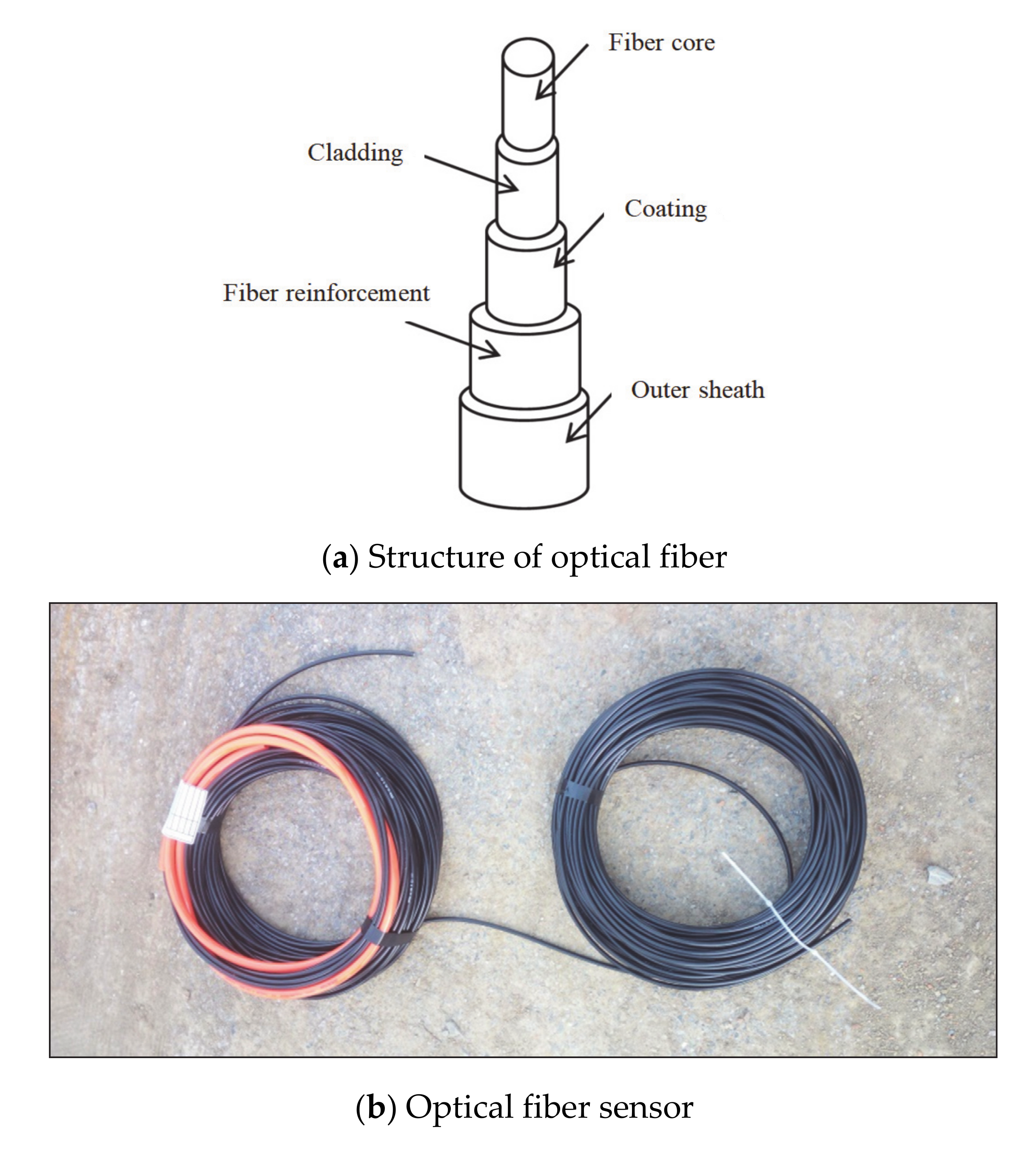
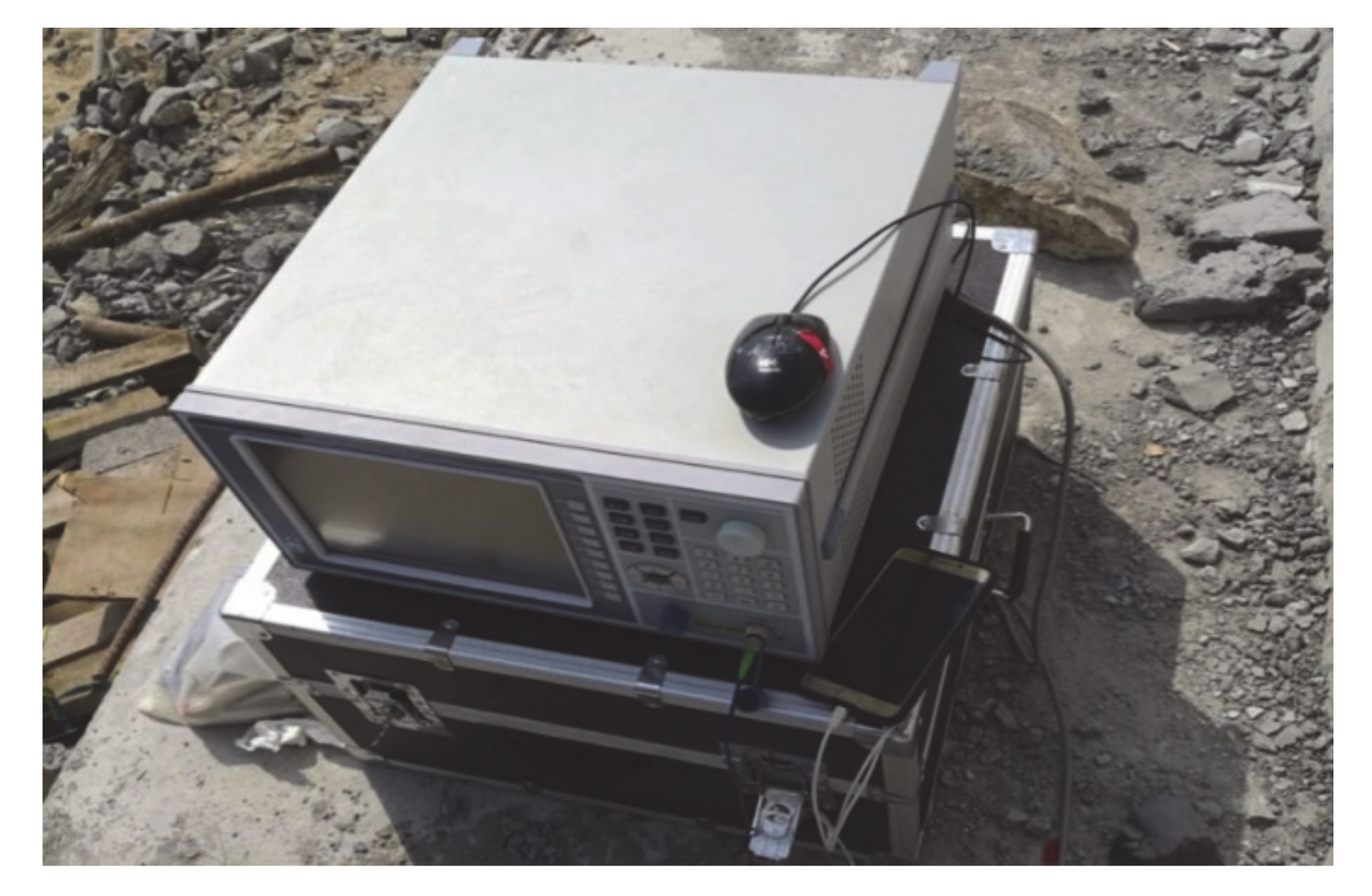
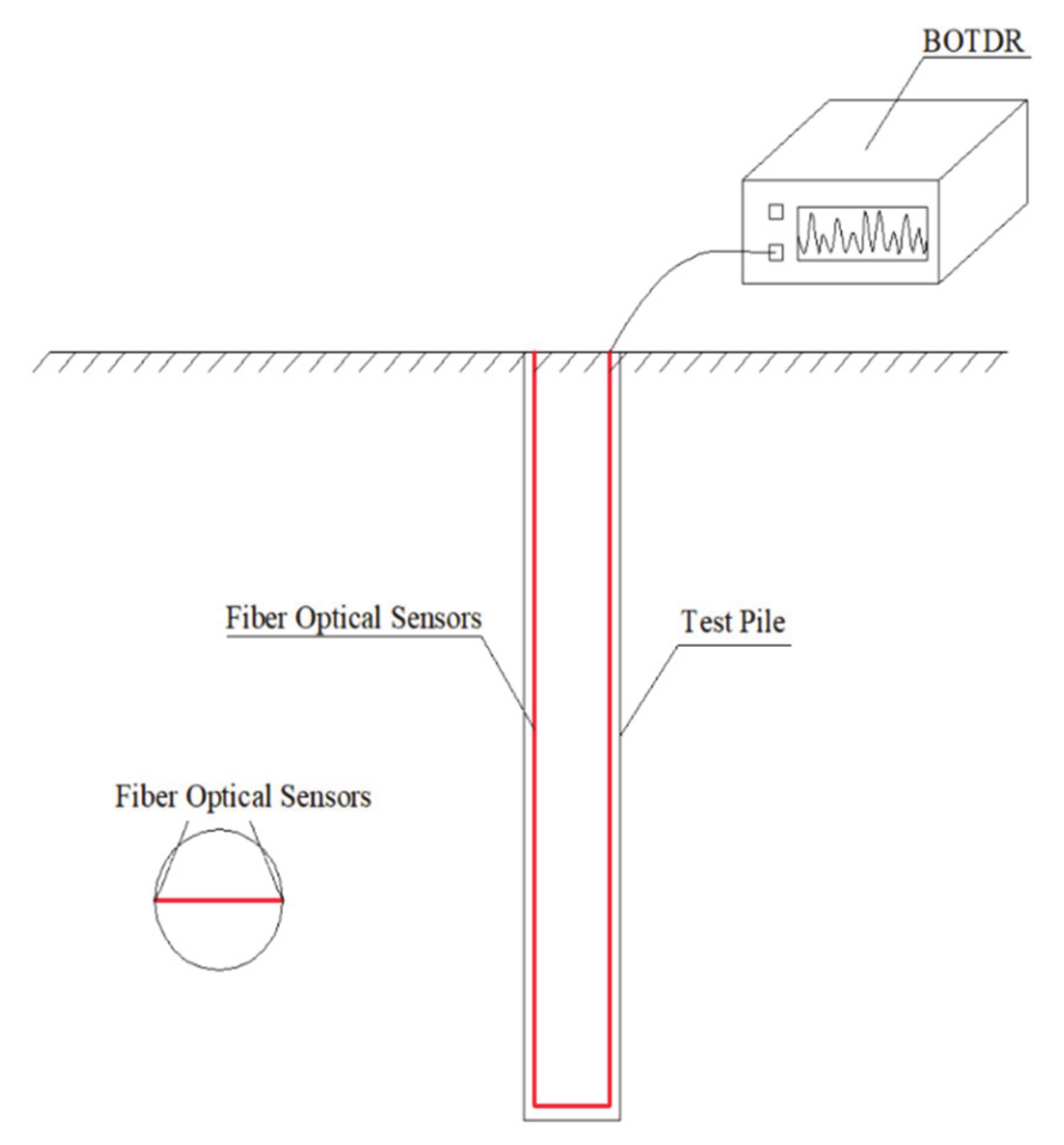
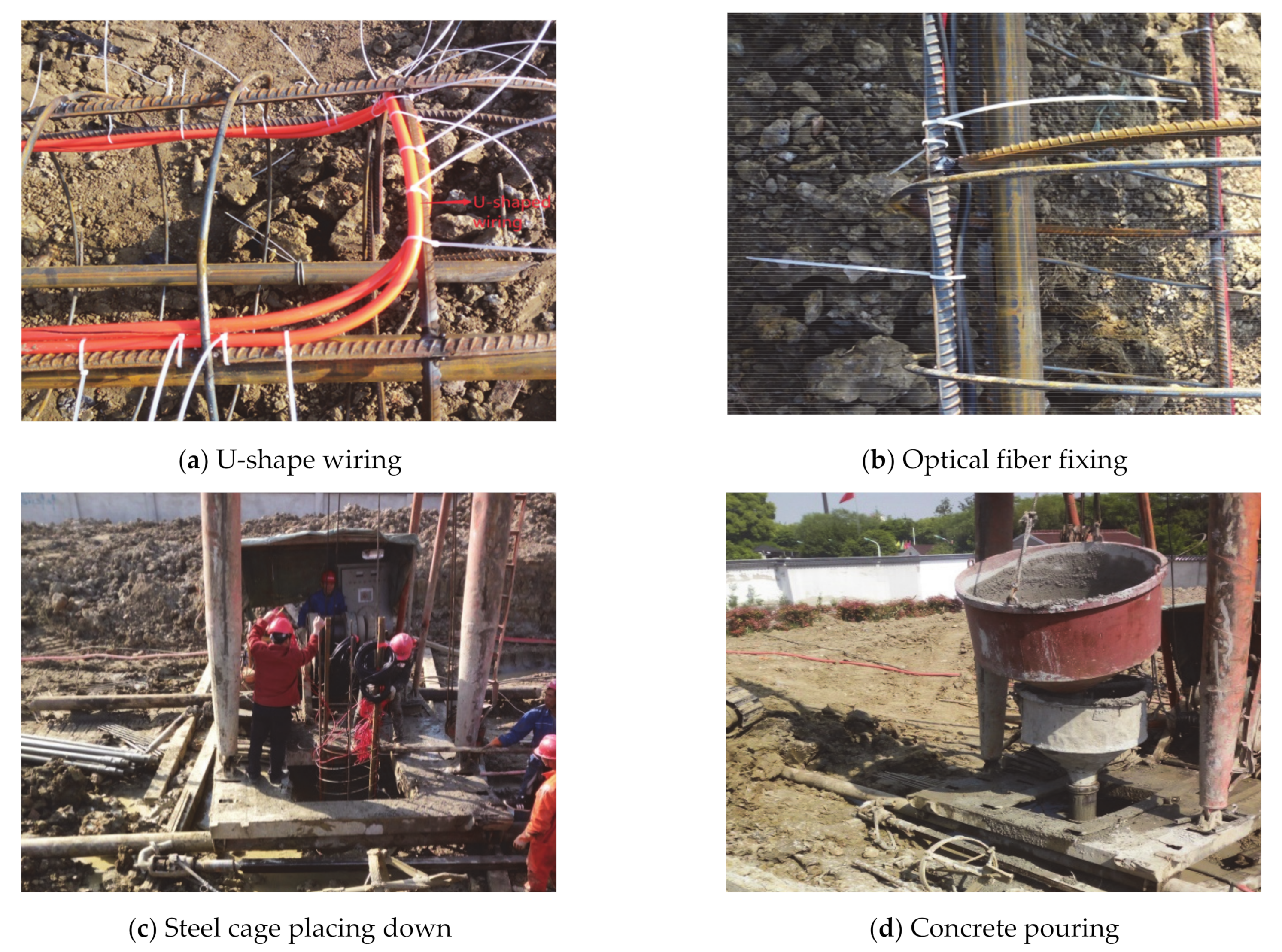
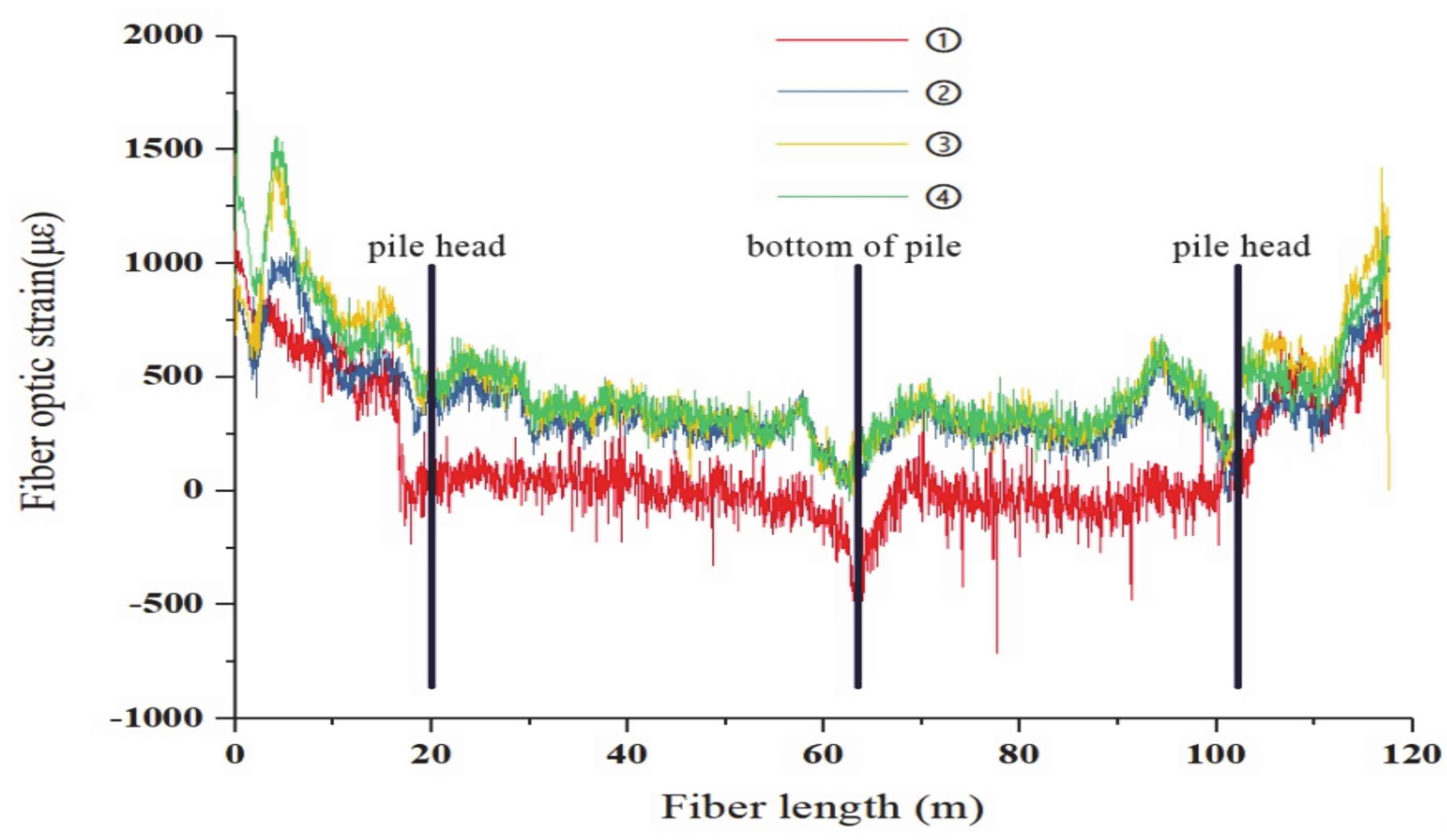
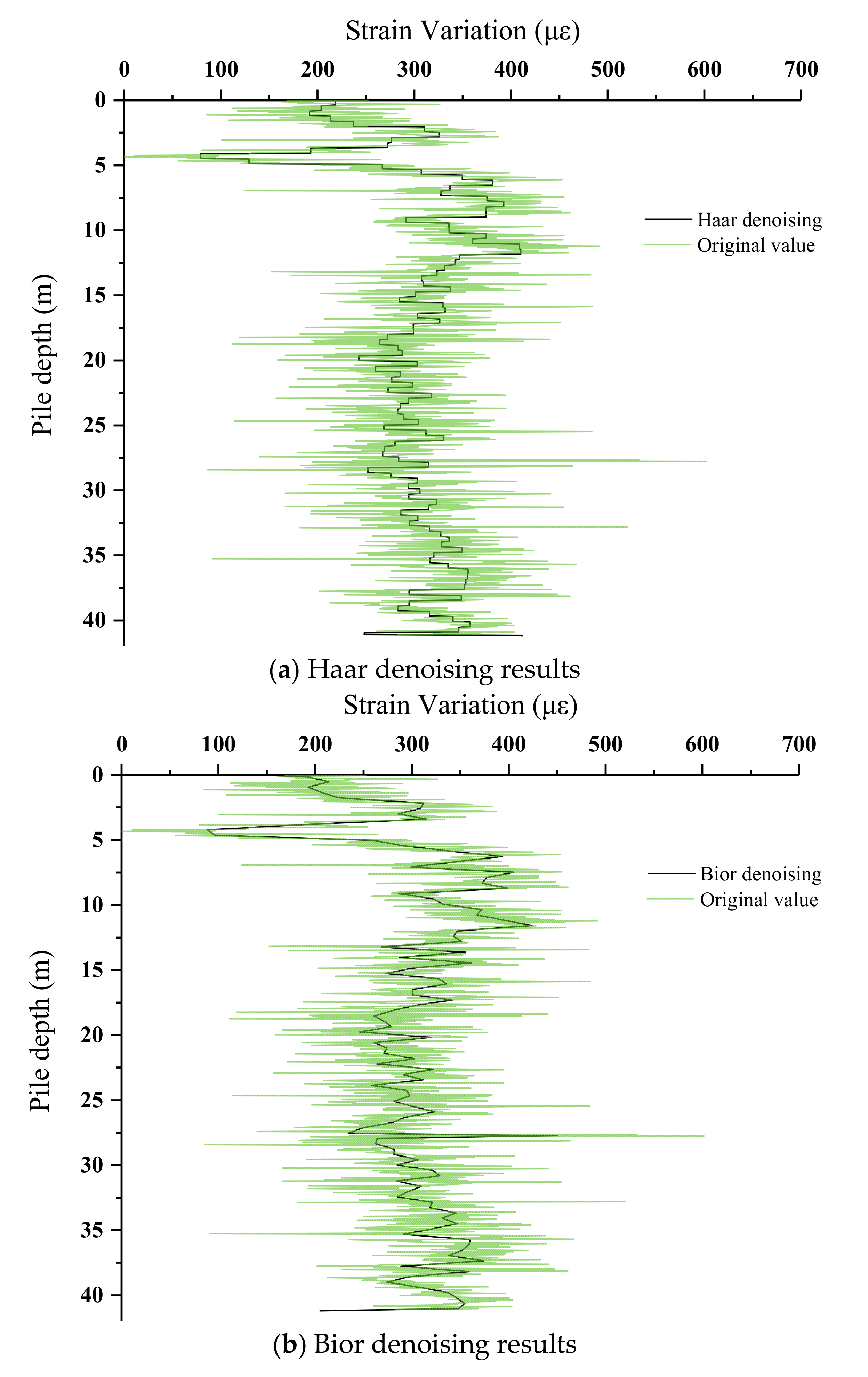
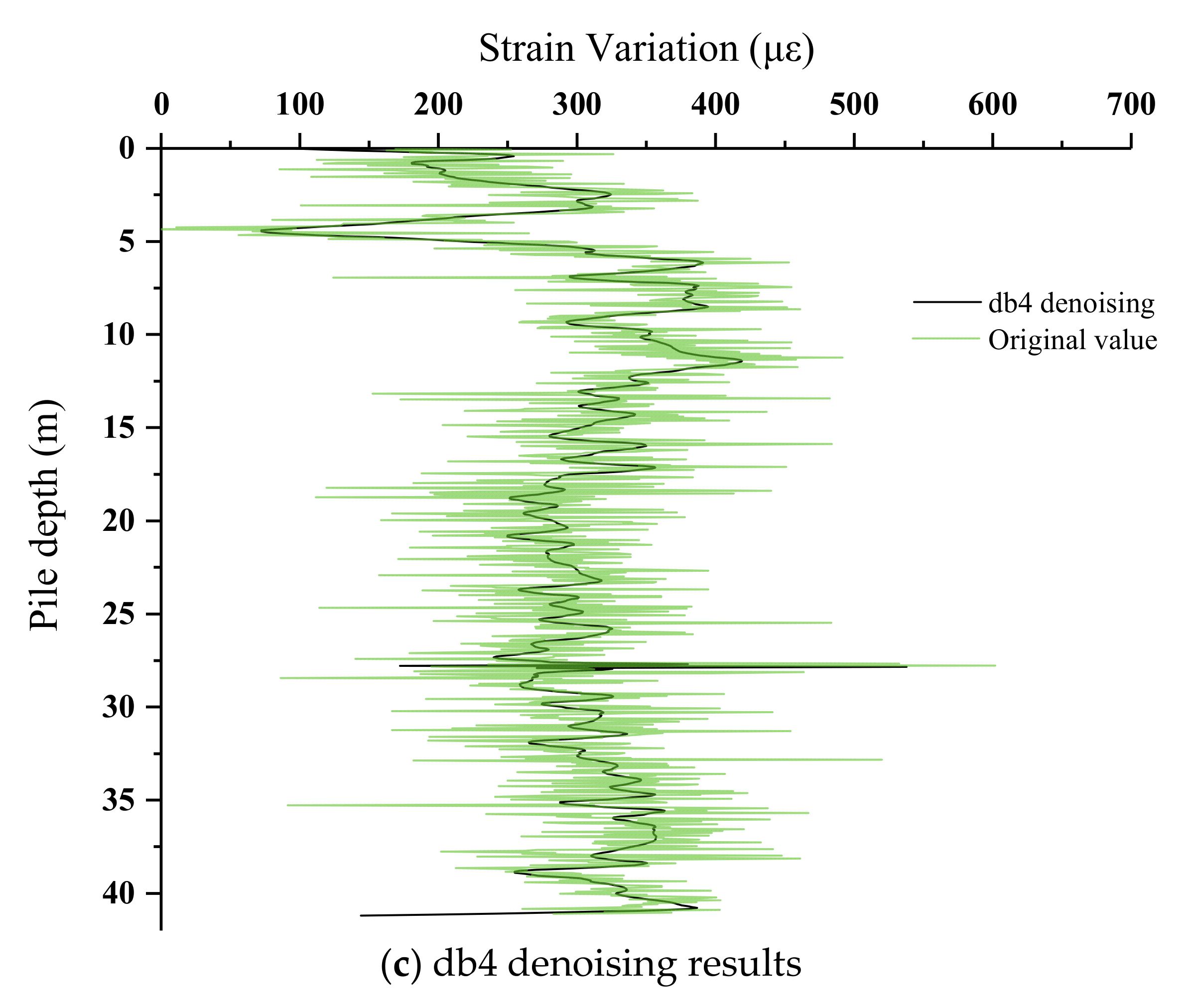
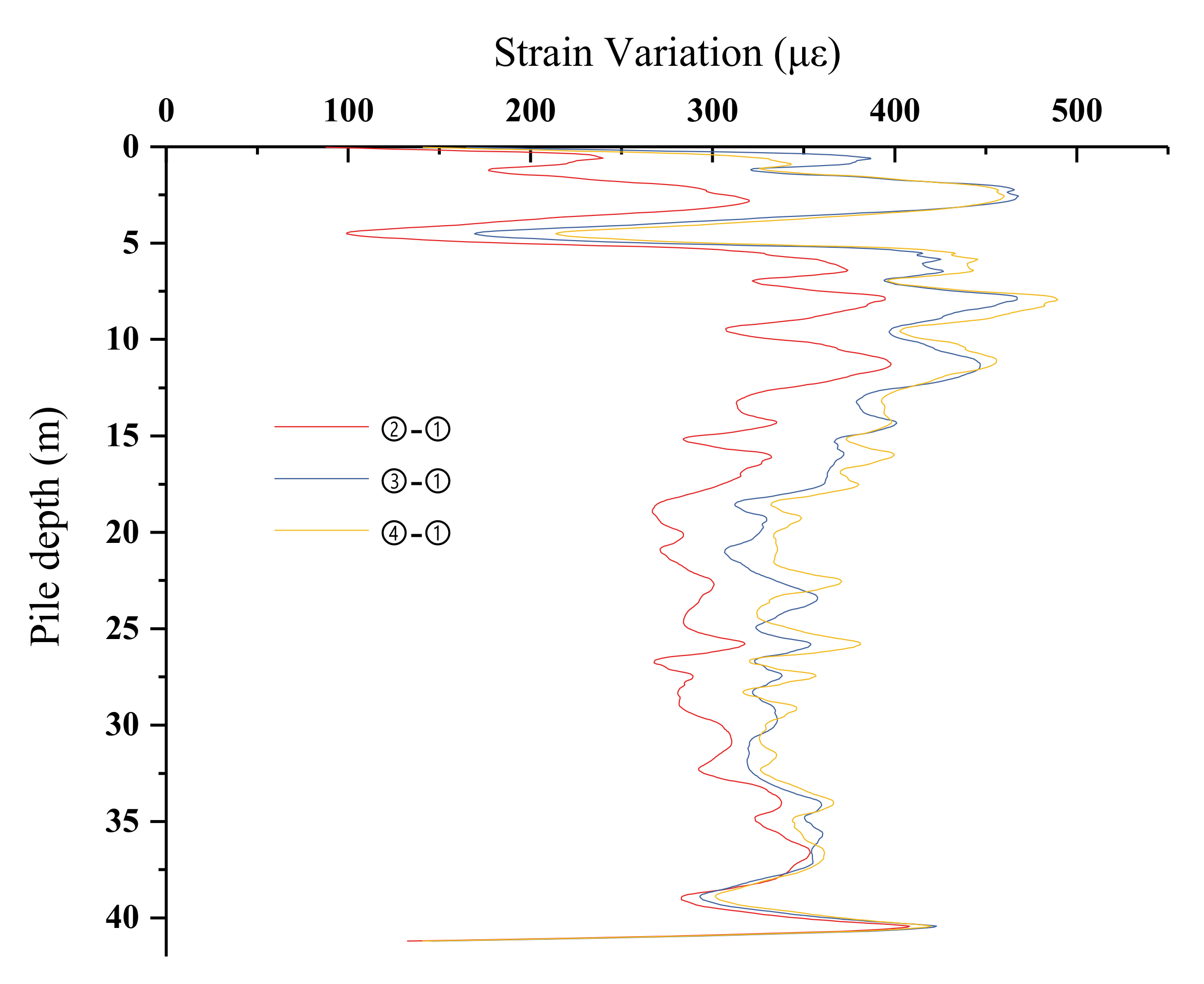
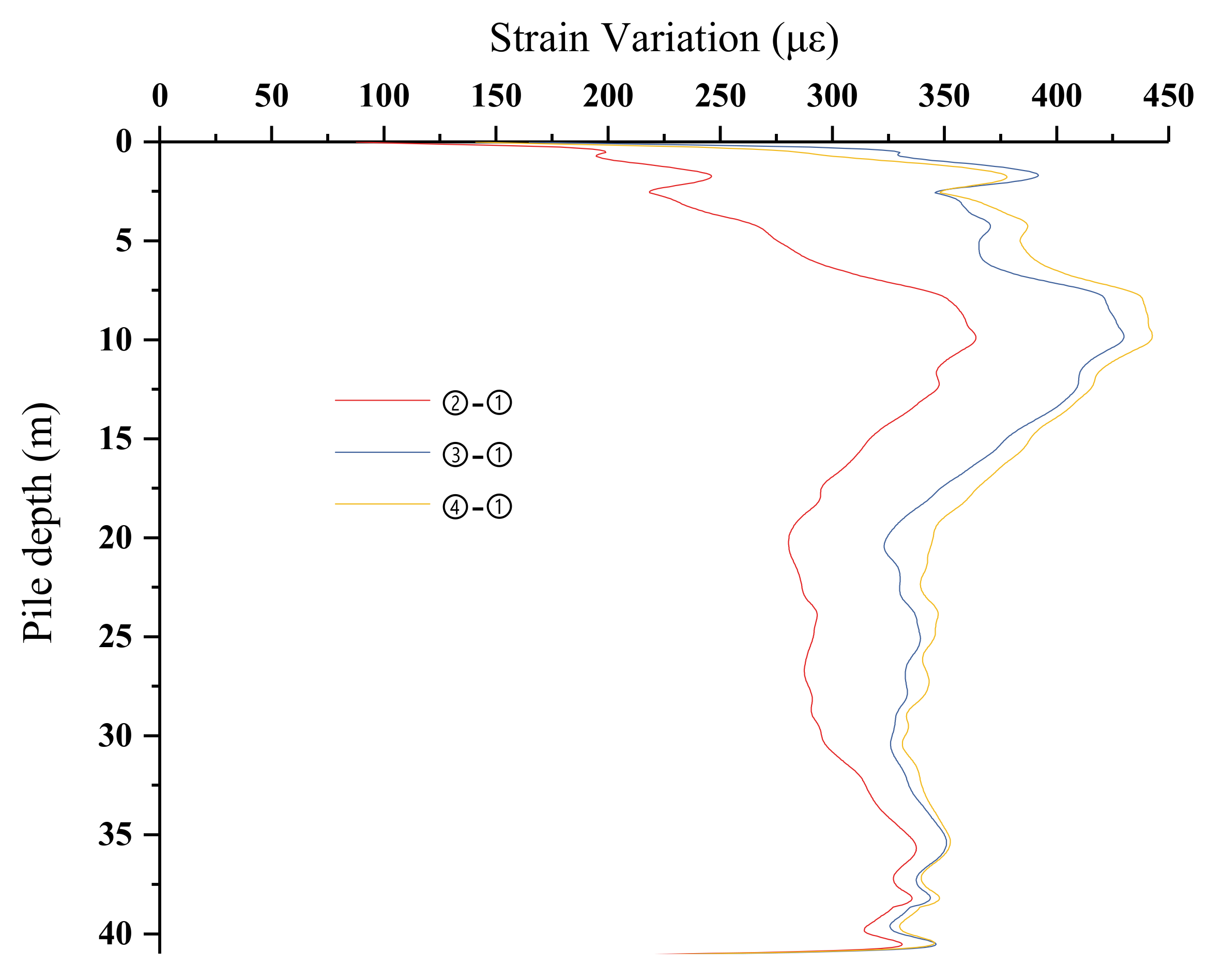
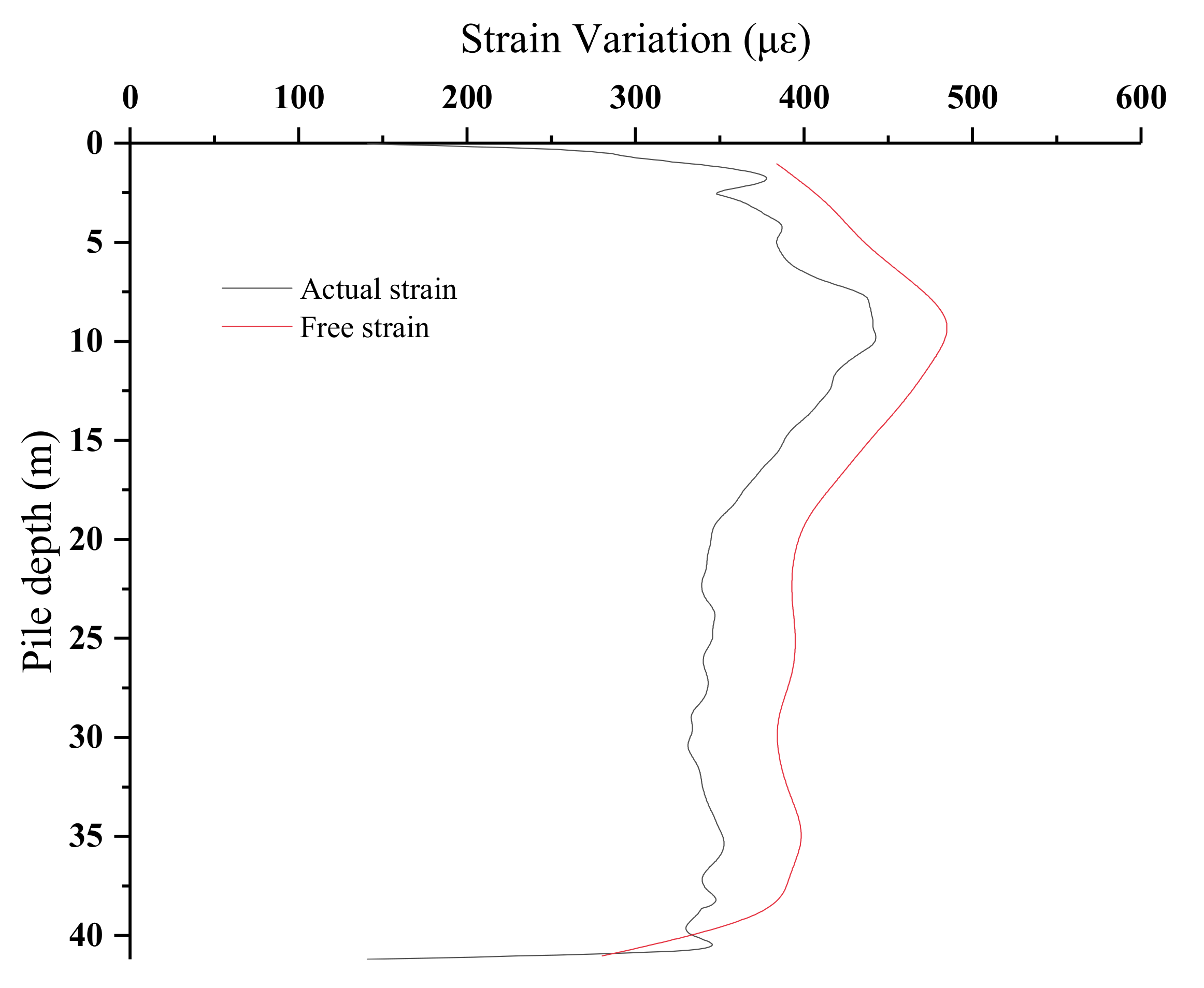
| Soil Layer Numbering | Soil Name | Thickness (m) | Density ρ (g/cm3) | Elastic Modulus E (MPa) | Cohesion C (kPa) | Internal Friction Angle φ (°) |
|---|---|---|---|---|---|---|
| ① | Plain fill | 3.55 | 1.90 | 18.5 | 30.9 | 24.6 |
| ② | Clay | 2.58 | 1.97 | 38.5 | 46.6 | 16.6 |
| ③ | Silty clay | 2.89 | 1.89 | 29.5 | 31.1 | 21.6 |
| ④ | Silt | 3.45 | 1.88 | 41.0 | 6.2 | 26.8 |
| ⑤ | Silty sand | 4.91 | 1.93 | 43.0 | 3.8 | 29.4 |
| ⑥ | Silty clay | 6.44 | 1.89 | 23.0 | 30.9 | 20.4 |
| ⑦-1 | Silty clay | 3.08 | 1.88 | 21.5 | 30 | 19.7 |
| ⑦-2 | Silty clay and silt interbed | 3.55 | 1.91 | 41.0 | 3.9 | 28.2 |
| ⑧ | Silty sand | — | 1.93 | 42.0 | 3.8 | 29.4 |
| Project Name | Parameter Settings | Project Name | Parameter Settings |
|---|---|---|---|
| Range | 0.5 km | Pulse Width | 10 ns |
| Resolution Ratio | 0.05 m | Starting Frequency | 10.700 GHz |
| CS | 0.0500 MHz/με | Stop Frequency | 11.200 GHz |
| fB0 | 10.800 GHz | Frequency Space | 5 MHz |
| Refractive Index | 1.4650 | Data Points | 10,240 |
| Serial Number | Measurement Interval | Ambient Temperature | Note |
|---|---|---|---|
| ① | 0 h | 23 °C | Measure after concrete pouring |
| ② | 24 h | 20 °C | |
| ③ | 48 h | 19 °C | |
| ④ | 72 h | 21 °C |
| Base Function Type | dbN | Haar | BiorNr. Nd |
|---|---|---|---|
| Orthogonality | Yes | Yes | No |
| Tight branch | Yes | Yes | Yes |
| Symmetry | Weak symmetry | Approximate symmetrical | Yes |
| Support width | 2N-1 | 1 | 2Nr + 1 2Nd + 1 |
| Lost moment | N | 1 | Nr |
Publisher’s Note: MDPI stays neutral with regard to jurisdictional claims in published maps and institutional affiliations. |
© 2021 by the authors. Licensee MDPI, Basel, Switzerland. This article is an open access article distributed under the terms and conditions of the Creative Commons Attribution (CC BY) license (http://creativecommons.org/licenses/by/4.0/).
Share and Cite
Gao, L.; Han, C.; Abdulhafidh, O.; Gong, Y.; Jin, Y. An Application of BOTDR to the Measurement of the Curing of a Bored Pile. Appl. Sci. 2021, 11, 418. https://doi.org/10.3390/app11010418
Gao L, Han C, Abdulhafidh O, Gong Y, Jin Y. An Application of BOTDR to the Measurement of the Curing of a Bored Pile. Applied Sciences. 2021; 11(1):418. https://doi.org/10.3390/app11010418
Chicago/Turabian StyleGao, Lei, Chuan Han, Omar Abdulhafidh, Yunhao Gong, and Yingjie Jin. 2021. "An Application of BOTDR to the Measurement of the Curing of a Bored Pile" Applied Sciences 11, no. 1: 418. https://doi.org/10.3390/app11010418
APA StyleGao, L., Han, C., Abdulhafidh, O., Gong, Y., & Jin, Y. (2021). An Application of BOTDR to the Measurement of the Curing of a Bored Pile. Applied Sciences, 11(1), 418. https://doi.org/10.3390/app11010418





